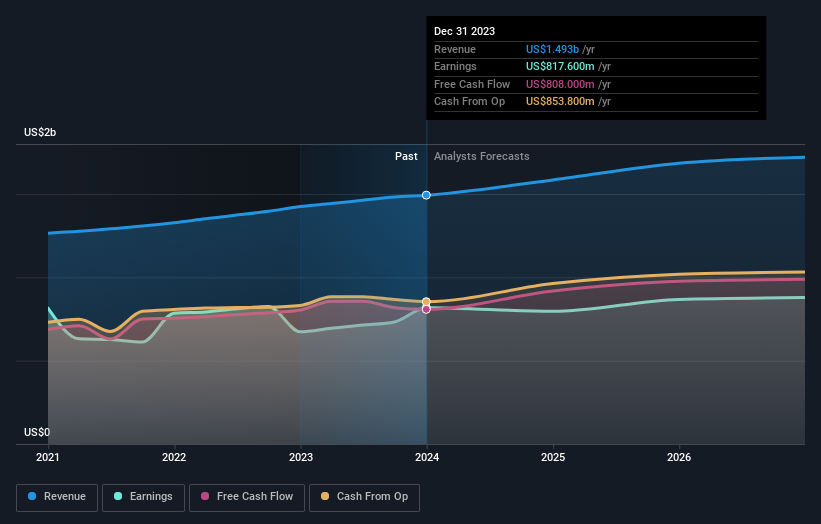- United States
- /
- IT
- /
- NasdaqGS:VRSN
VeriSign, Inc. Just Beat EPS By 9.6%: Here's What Analysts Think Will Happen Next

Last week saw the newest annual earnings release from VeriSign, Inc. (NASDAQ:VRSN), an important milestone in the company's journey to build a stronger business. The result was positive overall - although revenues of US$1.5b were in line with what the analysts predicted, VeriSign surprised by delivering a statutory profit of US$7.90 per share, modestly greater than expected. Following the result, the analysts have updated their earnings model, and it would be good to know whether they think there's been a strong change in the company's prospects, or if it's business as usual. We thought readers would find it interesting to see the analysts latest (statutory) post-earnings forecasts for next year.
View our latest analysis for VeriSign

After the latest results, the four analysts covering VeriSign are now predicting revenues of US$1.58b in 2024. If met, this would reflect a credible 6.1% improvement in revenue compared to the last 12 months. Statutory per share are forecast to be US$7.92, approximately in line with the last 12 months. Yet prior to the latest earnings, the analysts had been anticipated revenues of US$1.60b and earnings per share (EPS) of US$8.17 in 2024. So it looks like there's been a small decline in overall sentiment after the recent results - there's been no major change to revenue estimates, but the analysts did make a minor downgrade to their earnings per share forecasts.
It might be a surprise to learn that the consensus price target was broadly unchanged at US$223, with the analysts clearly implying that the forecast decline in earnings is not expected to have much of an impact on valuation. That's not the only conclusion we can draw from this data however, as some investors also like to consider the spread in estimates when evaluating analyst price targets. There are some variant perceptions on VeriSign, with the most bullish analyst valuing it at US$241 and the most bearish at US$200 per share. The narrow spread of estimates could suggest that the business' future is relatively easy to value, or thatthe analysts have a strong view on its prospects.
Taking a look at the bigger picture now, one of the ways we can understand these forecasts is to see how they compare to both past performance and industry growth estimates. It's clear from the latest estimates that VeriSign's rate of growth is expected to accelerate meaningfully, with the forecast 6.1% annualised revenue growth to the end of 2024 noticeably faster than its historical growth of 4.5% p.a. over the past five years. By contrast, our data suggests that other companies (with analyst coverage) in a similar industry are forecast to grow their revenue at 10% per year. So it's clear that despite the acceleration in growth, VeriSign is expected to grow meaningfully slower than the industry average.
The Bottom Line
The biggest concern is that the analysts reduced their earnings per share estimates, suggesting business headwinds could lay ahead for VeriSign. On the plus side, there were no major changes to revenue estimates; although forecasts imply they will perform worse than the wider industry. The consensus price target held steady at US$223, with the latest estimates not enough to have an impact on their price targets.
Keeping that in mind, we still think that the longer term trajectory of the business is much more important for investors to consider. At Simply Wall St, we have a full range of analyst estimates for VeriSign going out to 2026, and you can see them free on our platform here..
It is also worth noting that we have found 3 warning signs for VeriSign (1 can't be ignored!) that you need to take into consideration.
New: Manage All Your Stock Portfolios in One Place
We've created the ultimate portfolio companion for stock investors, and it's free.
• Connect an unlimited number of Portfolios and see your total in one currency
• Be alerted to new Warning Signs or Risks via email or mobile
• Track the Fair Value of your stocks
Have feedback on this article? Concerned about the content? Get in touch with us directly. Alternatively, email editorial-team (at) simplywallst.com.
This article by Simply Wall St is general in nature. We provide commentary based on historical data and analyst forecasts only using an unbiased methodology and our articles are not intended to be financial advice. It does not constitute a recommendation to buy or sell any stock, and does not take account of your objectives, or your financial situation. We aim to bring you long-term focused analysis driven by fundamental data. Note that our analysis may not factor in the latest price-sensitive company announcements or qualitative material. Simply Wall St has no position in any stocks mentioned.
About NasdaqGS:VRSN
VeriSign
Provides domain name registry services and internet infrastructure that enables internet navigation for various recognized domain names worldwide.
Solid track record and fair value.


